茶文化(英语)
茶文化英语介绍
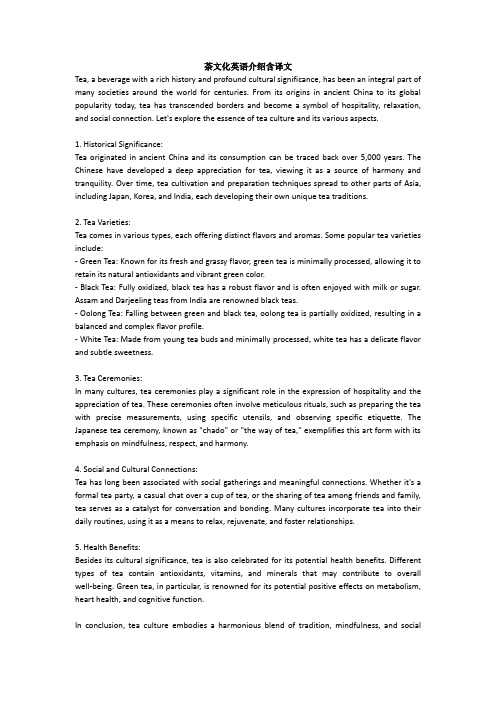
茶文化英语介绍含译文Tea, a beverage with a rich history and profound cultural significance, has been an integral part of many societies around the world for centuries. From its origins in ancient China to its global popularity today, tea has transcended borders and become a symbol of hospitality, relaxation, and social connection. Let's explore the essence of tea culture and its various aspects.1. Historical Significance:Tea originated in ancient China and its consumption can be traced back over 5,000 years. The Chinese have developed a deep appreciation for tea, viewing it as a source of harmony and tranquility. Over time, tea cultivation and preparation techniques spread to other parts of Asia, including Japan, Korea, and India, each developing their own unique tea traditions.2. Tea Varieties:Tea comes in various types, each offering distinct flavors and aromas. Some popular tea varieties include:- Green Tea: Known for its fresh and grassy flavor, green tea is minimally processed, allowing it to retain its natural antioxidants and vibrant green color.- Black Tea: Fully oxidized, black tea has a robust flavor and is often enjoyed with milk or sugar. Assam and Darjeeling teas from India are renowned black teas.- Oolong Tea: Falling between green and black tea, oolong tea is partially oxidized, resulting in a balanced and complex flavor profile.- White Tea: Made from young tea buds and minimally processed, white tea has a delicate flavor and subtle sweetness.3. Tea Ceremonies:In many cultures, tea ceremonies play a significant role in the expression of hospitality and the appreciation of tea. These ceremonies often involve meticulous rituals, such as preparing the tea with precise measurements, using specific utensils, and observing specific etiquette. The Japanese tea ceremony, known as "chado" or "the way of tea," exemplifies this art form with its emphasis on mindfulness, respect, and harmony.4. Social and Cultural Connections:Tea has long been associated with social gatherings and meaningful connections. Whether it's a formal tea party, a casual chat over a cup of tea, or the sharing of tea among friends and family, tea serves as a catalyst for conversation and bonding. Many cultures incorporate tea into their daily routines, using it as a means to relax, rejuvenate, and foster relationships.5. Health Benefits:Besides its cultural significance, tea is also celebrated for its potential health benefits. Different types of tea contain antioxidants, vitamins, and minerals that may contribute to overall well-being. Green tea, in particular, is renowned for its potential positive effects on metabolism, heart health, and cognitive function.In conclusion, tea culture embodies a harmonious blend of tradition, mindfulness, and socialconnection. With its diverse varieties, meaningful ceremonies, and health benefits, tea continues to be cherished and enjoyed by people from various cultures worldwide. Whether you're sipping a soothing cup of green tea or participating in an elaborate tea ceremony, tea invites us to appreciate the simple joys of life and embrace moments of tranquility.译文:茶是一种具有悠久历史和深厚文化意义的饮料,几个世纪以来一直是世界各地许多社会不可或缺的一部分。
茶文化的英语单词怎么写论述
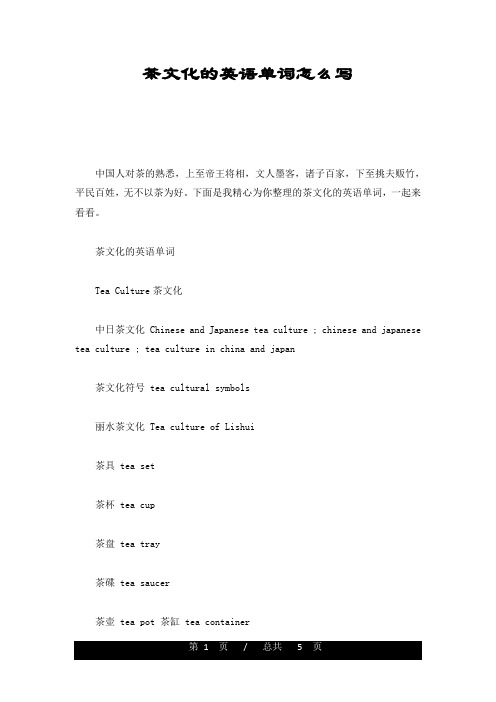
茶文化的英语单词怎么写中国人对茶的熟悉,上至帝王将相,文人墨客,诸子百家,下至挑夫贩竹,平民百姓,无不以茶为好。
下面是我精心为你整理的茶文化的英语单词,一起来看看。
茶文化的英语单词Tea Culture茶文化中日茶文化 Chinese and Japanese tea culture ; chinese and japanese tea culture ; tea culture in china and japan茶文化符号 tea cultural symbols丽水茶文化 Tea culture of Lishui茶具 tea set茶杯 tea cup茶盘 tea tray茶碟 tea saucer茶壶 tea pot 茶缸 tea container紫砂茶壶 ceramic tea pot茶叶罐 tea caddy茶杯垫 coaster 茶壶套 tea cosy 滤茶器 tea strainer茶匙 teaspoon新茶 fresh tea砖茶 brick tea毛茶 crudely tea散茶 loose tea碎茶 broken tea香片 perfumed tea茶片 tea siftings花茶 scentedjasmine tea茶叶梗 tea stale, tea stem沏新茶 making fresh tea上茶offering tea, tea serving 淡茶weak tea浓茶 strong tea抿茶 sipping tea茶园 tea garden茶馆tea house茶几 tea table茶篮 tea basket滤茶球 tea ball减肥茶 dietslimmingtea保健茶 tonic tea凉茶精 herb ingredients美容茶 cosmetic tea人参茶ginseng tea姜茶 ginger tea速溶茶instant tea茶叶蛋 salty eggs cooked in tea擂茶 mashed tea盖碗茶 tea served in a set of cups茶叶表演 tea-serving performance茶叶种类介绍1. 绿茶:茶是不经过发酵的茶,即将鲜叶经过摊晾后直接下到一二百度的热锅里炒制,以保持其绿色的特点。
关于中国茶文化的英语词汇语块和句式表达
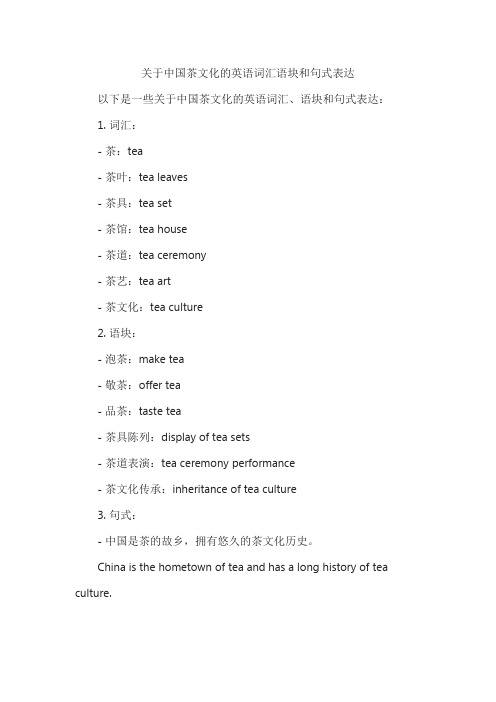
关于中国茶文化的英语词汇语块和句式表达以下是一些关于中国茶文化的英语词汇、语块和句式表达:1. 词汇:- 茶:tea- 茶叶:tea leaves- 茶具:tea set- 茶馆:tea house- 茶道:tea ceremony- 茶艺:tea art- 茶文化:tea culture2. 语块:- 泡茶:make tea- 敬茶:offer tea- 品茶:taste tea- 茶具陈列:display of tea sets- 茶道表演:tea ceremony performance- 茶文化传承:inheritance of tea culture3. 句式:- 中国是茶的故乡,拥有悠久的茶文化历史。
China is the hometown of tea and has a long history of tea culture.- 茶道是一种通过泡茶、敬茶和品茶等环节来表达敬意和感恩的艺术形式。
Tea ceremony is an art form that expresses respect and gratitude through the procedures of making, offering and tasting tea.- 茶文化是中国传统文化的重要组成部分,它体现了中国人对生活品质和精神追求的追求。
Tea culture is an important part of Chinese traditional culture, embodying the Chinese people's pursuit of life quality and spiritual pursuit.- 中国的茶馆是人们休闲、社交和品尝茶文化的好去处。
Chinese tea houses are good places for people to relax, socialize and experience tea culture.- 学习茶道可以帮助人们提高修养、培养内心平静和增进人际关系。
茶文化英语作文80词

茶文化英语作文80词英文回答:Tea culture is an integral part of many cultures around the world, with different countries and regions havingtheir unique customs and traditions associated with the beverage. In China, tea has been cultivated and consumedfor thousands of years, and its significance extends far beyond its taste. Tea is deeply woven into the fabric of Chinese society, playing a vital role in social interactions, religious ceremonies, and medicinal practices.The Chinese tea ceremony is an elaborate ritual that embodies the country's rich cultural heritage. It is atime-honored tradition that involves the preparation and serving of tea with great care and attention to detail. The ceremony is often conducted in a serene setting, with participants gathered around a table to share in the experience. The host prepares the tea using traditional methods, and guests are invited to savor the beverage andappreciate its delicate flavors and aromas.In addition to its social and cultural importance, tea also holds a significant place in Chinese medicine. For centuries, herbal teas have been used to treat a wide range of ailments, from headaches to digestive problems. Traditional Chinese medicine practitioners believe that different teas have specific therapeutic properties, and they often recommend them as part of a holistic approach to healing.中文回答:茶文化是世界许多国家和地区不可或缺的一部分,不同的国家和地区有其独特的风俗和习惯与饮料有关。
英语介绍茶文化

英语介绍茶文化English:Tea culture is a rich and intricate part of Chinese history, dating back thousands of years. It encompasses not just the act of drinking tea, but also the cultivation, processing, and appreciation of tea leaves. With its origins in ancient China, tea has evolved into a symbol of hospitality, respect, and harmony. The tea ceremony, known as "茶道" (chá dào) or "茶艺" (chá yì), is a ceremonial way of preparing and serving tea, embodying principles of Zen Buddhism such as harmony, respect, purity, and tranquility. Different regions in China have their own unique tea cultures, with famous varieties like green tea, black tea, oolong tea, and Pu'er tea. Each type of tea has its own distinct flavor profile, health benefits, and cultural significance. Beyond China, tea culture has spread across the globe, influencing various rituals, customs, and lifestyles. It has become an integral part of social interactions, whether it's the English tradition of afternoon tea or the Japanese tea ceremony. Overall, tea culture is not just about the beverage itself but also about the values, traditions, and rituals associated with it, making it a fascinating and essential aspect of Chinese heritage.中文翻译:茶文化是中国历史上丰富而复杂的一部分,可以追溯到几千年前。
中国茶文化-英语

Chinese tea culture(中国茶文化-英文版)The Chinese people, in their drinking of tea, place much significance on the act of "savoring." "Savoring tea" is not only a way to discern (识别,辨别)good tea from mediocre (普通的,平凡的)tea, but also how people take delight in their reverie(沉思)and in tea-drinking itself. Snatching a bit of leisure from a busy schedule, making a kettle of strong tea, securing a serene (平静的,安详的)space, and serving and drinking tea by yourself can help banish fatigue and frustration, improve your thinking ability and inspire you with enthusiasm. You may also imbibe(啜)it slowly in small sips to appreciate the subtle allure of tea-drinking, until your spirits soar up and up into a sublime(超群的)aesthetic(美的,美学的)realm(领域). Buildings, gardens, ornaments and tea sets are the elements that form the ambience (气氛,周围环境)for savoring tea. A tranquil, refreshing, comfortable and neat locale is certainly desirable for drinking tea. Chinese gardens are well known in the world and beautiful Chinese landscapes are too numerous to count. Teahouses tucked away in gardens and nestled beside the natural beauty of mountains and rivers are enchanting places of repose for people to rest and recreate themselves.China is a country with a time-honored civilization and a land of ceremony and decorum. Whenever guests visit, it is necessary to make and serve tea to them. Before serving tea, you may ask them for their preferences as to what kind of tea they fancy and serve them the tea in the most appropriate teacups. In the course of serving tea, the host should take careful note of how much water is remaining in the cups and in the kettle. Usually, if the tea is made in a teacup, boiling water should be added after half of the cup has been consumed; and thus the cup is kept filled so that the tea retains the same bouquet and remains pleasantly warm throughout the entire course of tea-drinking. Snacks, sweets and other dishes may be served at tea time to complement the fragrance of the tea and to allay one‘s hunger中国人饮茶,注重一个“品”字。
茶文化英语带翻译
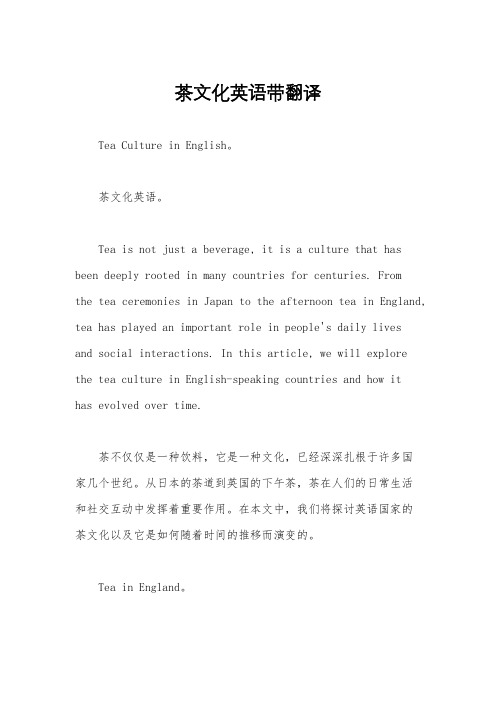
茶文化英语带翻译Tea Culture in English。
茶文化英语。
Tea is not just a beverage, it is a culture that has been deeply rooted in many countries for centuries. Fromthe tea ceremonies in Japan to the afternoon tea in England, tea has played an important role in people's daily livesand social interactions. In this article, we will explore the tea culture in English-speaking countries and how ithas evolved over time.茶不仅仅是一种饮料,它是一种文化,已经深深扎根于许多国家几个世纪。
从日本的茶道到英国的下午茶,茶在人们的日常生活和社交互动中发挥着重要作用。
在本文中,我们将探讨英语国家的茶文化以及它是如何随着时间的推移而演变的。
Tea in England。
英国的茶文化。
Tea has been a popular beverage in England since the17th century, when it was introduced by Catherine of Braganza, the queen consort of King Charles II. However, it was not until the 19th century that tea became a staple of British culture, thanks to the development of tea plantations in India and the reduction of its price. This led to the creation of the tradition of afternoon tea, which is still popular today.自17世纪以来,茶在英国一直是一种受欢迎的饮料,当时由查尔斯二世国王的皇后卡瑟琳·布拉干萨引入。
【关于茶文化的英文作文】茶文化英文

【关于茶文化的英文作文】茶文化英文【关于茶文化的英文作文】茶文化英文茶文化的发展回事我们的使命,所以出现了很多的关于茶文化的英文作文和论文。
下面是小编精心为你整理的关于茶文化的英文作文,一起来看看。
关于茶文化的英文作文1 茶文化Chinese tea Chinese tea culture, tea culture. As open seven things , one of tea in ancient China is very common. Chinese tea culture and tea culture in Europe and America or Japan, a great difference. Chinese tea culture has a long history, profound, not only contains the material and cultural level, also contains a deep spiritual level.Tea by Lu Yu of the Tang Dynasty in the history of Chinese tea culture and sounded the horn. Since then, the spirit of tea permeates the court and society, into the Chinese poetry, painting, calligraphy, religion, medicine. For thousands of years China has not only accumulated a great deal about tea cultivation, production of material culture, but also accumulated rich spirit of the tea culture, which is unique to China’s tea culture, a cultural study areas.中国茶,茶文化,茶文化。
高考英语作文茶文化

高考英语作文之茶文化1Tea culture has a profound and long history in China, embodying not only a drink but also a reflection of wisdom and art. China boasts a wide variety of teas, among which green tea, black tea, and oolong tea are highly favored. Green tea is renowned for its fresh and delicate flavor, rich in antioxidants that are beneficial for health. Black tea, on the other hand, has a robust and mellow taste, often used in blends and enjoyed with milk or sugar. Oolong tea stands out with its unique aroma and complex flavor profile.The traditional way of making tea in China is an elaborate process. Fine tea leaves are carefully selected and placed in a specially designed tea pot. Hot water of the appropriate temperature is poured gently over the leaves, allowing them to unfurl and release their essence. The infusion time is crucial to achieving the perfect flavor.The choice of tea sets also plays a significant role. Delicate porcelain cups or clay pots are commonly used, each adding to the aesthetic appeal and enhancing the tea-drinking experience.In conclusion, Chinese tea culture is a treasure trove of traditions and craftsmanship. It brings people not only the pleasure of taste but also a spiritual enjoyment and a connection to history and culture.2Tea culture has been an integral part of Chinese life for centuries, and its charm is truly remarkable. In China, tea plays a significant role in social gatherings. When friends come together, they often enjoy a cup of fragrant tea while engaging in heartfelt conversations. This not only provides a pleasant atmosphere but also deepens the bonds between them.The traditional customs and etiquette associated with tea are equally fascinating. For instance, when serving tea to guests, it is important to show respect by using proper gestures and a polite manner. The order of serving and the way the tea is presented all carry symbolic meanings.Moreover, the types of tea available in China are numerous, each with its own unique characteristics and flavors. Green tea, black tea, oolong tea, and others all have their devoted followers. The process of making tea is also an art form, requiring precise control of water temperature and steeping time to bring out the best taste.In conclusion, Chinese tea culture is not just about drinking a beverage; it is a reflection of our heritage, a symbol of hospitality, and a means of fostering connections. It is a precious gem that continues to shine in the rich tapestry of Chinese traditions.3Tea culture has been an integral part of Chinese life for centuries,exerting a profound and far-reaching influence. Tea is not merely a beverage; it is a symbol of tranquility and a source of relaxation. When people are stressed and exhausted after a long day of work or study, a cup of fragrant tea can soothe their nerves and alleviate their fatigue. The act of brewing and sipping tea becomes a moment of respite, allowing them to forget the hustle and bustle of daily life and find inner peace.Furthermore, tea plays a significant role in maintaining good health. It is rich in various beneficial substances that contribute to our well-being. Regular consumption of tea can enhance our immune system, improve digestion, and prevent certain diseases. Many people incorporate tea into their daily routine as a natural and healthy choice.In family life, tea holds a special place. Gatherings around the tea table provide an opportunity for family members to come together, share stories, and strengthen their bonds. It is a time when generations communicate, passing down traditions and values. The aroma of tea fills the room, creating a warm and harmonious atmosphere.In conclusion, tea culture has deeply permeated every aspect of Chinese life. It brings comfort, health, and unity to people, making it an indispensable part of our heritage and identity.4Tea culture in China has a long and illustrious history that has undergone significant changes and developments over the centuries. Inancient times, tea was regarded as a precious commodity and was mainly consumed by the nobility and scholars. It was not only a beverage but also a symbol of refinement and elegance.As time went by, tea gradually became more accessible to the common people. During the Tang Dynasty, a famous figure named Lu Yu wrote the "Classic of Tea," which comprehensively documented the cultivation, processing, and drinking methods of tea. This work greatly promoted the spread and development of tea culture.In the Song Dynasty, tea ceremonies became highly elaborate and ritualistic. People paid great attention to the quality and variety of tea, as well as the art of brewing and presenting it.In modern times, tea has become an integral part of daily life for many Chinese people. The tea industry has also seen significant technological advancements, from improved cultivation techniques to innovative processing methods.Today, Chinese tea is renowned worldwide for its diverse varieties and rich cultural connotations. It not only quenches thirst but also serves as a medium for communication and cultural exchange. The evolution of tea culture reflects the changing social and cultural landscapes of China throughout history, and it continues to thrive and evolve, bringing joy and well-being to people's lives.5Tea culture, a profound and enchanting aspect of human civilization, holds significant value in international communication. The spread and popularity of Chinese tea around the world are remarkable. For instance, in the United Kingdom, the afternoon tea tradition has incorporated elements of Chinese tea, creating a unique blend of cultures. The delicate flavors and health benefits of Chinese tea have captured the hearts of people from various nations.Not only has Chinese tea gained popularity, but the exchange and integration of tea cultures among different countries have also flourished. In Japan, the tea ceremony is an exquisite art form that emphasizes harmony and tranquility. When it meets the diverse expressions of tea culture from other countries, a beautiful symphony of cultural diversity emerges.The value of tea culture in international communication lies not only in the sharing of beverages but also in the transmission of values and aesthetics. It promotes mutual understanding and appreciation among different nations. Through the exchange of tea culture, we can learn about the customs, philosophies, and ways of life of other countries. This interaction enriches our global perspective and builds bridges of friendship and cooperation.In conclusion, tea culture serves as a gentle and inviting ambassador,facilitating communication and connection across the boundaries of nations. It is a testament to the power of shared experiences and the beauty of cultural exchange.。
茶文化的英语单词怎么写

茶文化的英语单词怎么写TeaCulture茶文化中日茶文化ChineseandJapaneseteaculture;chineseandjapaneseteaculture;t eacultureinchinaandjapan茶文化符号teaculturalsymbols丽水茶文化TeacultureofLishui茶具teaset茶杯teacup茶盘teatray茶碟teasaucer茶壶teapot茶缸teacontainer紫砂茶壶ceramicteapot茶叶罐teacaddy茶杯垫coaster茶壶套teacosy滤茶器teastrainer茶匙teaspoon新茶freshtea砖茶bricktea毛茶crudelytea散茶loosetea碎茶brokentea香片perfumedtea茶片teasiftings花茶scented(jasmine)tea茶叶梗teastale,teastem沏新茶makingfreshtea上茶offeringtea,teaserving 淡茶weaktea浓茶strongtea抿茶sippingtea茶园teagarden茶馆teahouse茶几teatable茶篮teabasket滤茶球teaball减肥茶diet(slimming)tea保健茶tonictea凉茶精herbingredients美容茶cosmetictea人参茶ginsengtea姜茶gingertea速溶茶instanttea茶叶蛋saltyeggscookedintea 擂茶mashedtea盖碗茶teaservedinasetofcups茶叶表演tea-servingperformance1.绿茶:茶是不经过发酵的茶,即将鲜叶经过摊晾后直接下到一二百度的热锅里炒制,以保持其绿色的特点。
主要花色有:西湖龙井茶、日照绿茶、雪青茶、碧罗春茶、黄山毛峰茶、庐山云雾、六安瓜片、蒙顶茶、太平猴魁茶、顾渚紫笋茶、信阳毛尖茶、竹叶青、都匀毛尖、平水珠茶、西山茶、雁荡毛峰茶、华顶云雾茶、涌溪火青茶、敬亭绿雪茶、峨眉峨蕊茶、都匀毛尖茶、恩施玉露茶、婺源茗眉茶、雨花茶、莫干黄芽茶、五山盖米茶、普陀佛茶、西农毛尖。
英语作文茶文化
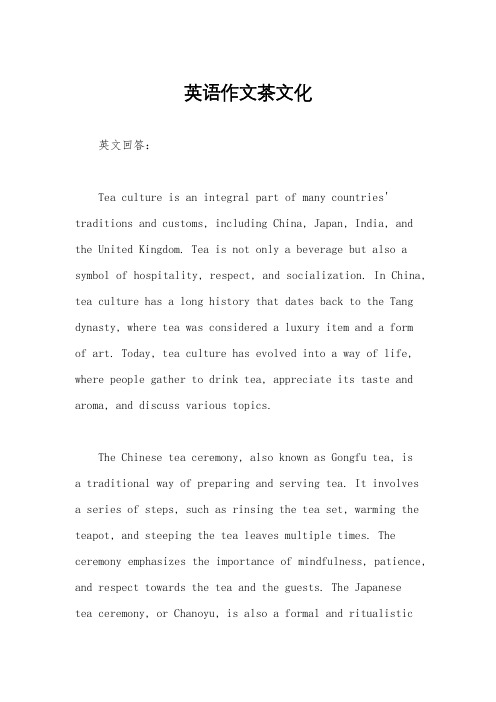
英语作文茶文化英文回答:Tea culture is an integral part of many countries' traditions and customs, including China, Japan, India, and the United Kingdom. Tea is not only a beverage but also a symbol of hospitality, respect, and socialization. In China, tea culture has a long history that dates back to the Tang dynasty, where tea was considered a luxury item and a formof art. Today, tea culture has evolved into a way of life, where people gather to drink tea, appreciate its taste and aroma, and discuss various topics.The Chinese tea ceremony, also known as Gongfu tea, isa traditional way of preparing and serving tea. It involves a series of steps, such as rinsing the tea set, warming the teapot, and steeping the tea leaves multiple times. The ceremony emphasizes the importance of mindfulness, patience, and respect towards the tea and the guests. The Japanesetea ceremony, or Chanoyu, is also a formal and ritualisticway of serving tea. It involves a series of precise movements, such as cleaning the tea utensils, preparing the tea, and presenting it to the guests. The ceremony emphasizes the principles of harmony, respect, purity, and tranquility.In India, chai tea is a popular beverage that is consumed daily by millions of people. Chai tea is a blend of black tea, spices, and milk, and it is often served with biscuits or snacks. Chai tea is not only a delicious beverage but also a symbol of hospitality and friendship. In the United Kingdom, tea is a national obsession, and it is often associated with the concept of afternoon tea. Afternoon tea is a tradition that dates back to the 19th century when the upper class would gather for tea, sandwiches, and cakes. Today, afternoon tea is a popular social activity that is enjoyed by people of all ages and backgrounds.Tea culture has many benefits, including promoting relaxation, enhancing socialization, and improving health. Tea contains antioxidants, which can help to reduce therisk of chronic diseases, such as cancer and heart disease. Tea also contains caffeine, which can improve mental alertness and concentration. Moreover, tea has a calming effect on the mind and body, which can reduce stress and anxiety.中文回答:茶文化是许多国家传统和习俗的重要组成部分,包括中国、日本、印度和英国。
茶文化英语作文初中简单

茶文化英语作文初中简单Tea culture is an important part of Chinese tradition.It has a long history and has been deeply integrated into the daily life of Chinese people. Tea culture is not only about drinking tea, but also about the art of making and serving tea, as well as the philosophy and etiquette behind it.First of all, Chinese people have a special way ofmaking and serving tea, which is called "Gongfu tea ceremony". This traditional way of making tea involves a series of precise and delicate steps, such as warming the teapot, rinsing the tea leaves, and pouring the water in a specific order. It requires skill, patience, and attentionto detail. The Gongfu tea ceremony is not only a way of making tea, but also a form of art that reflects the harmony between nature and human.Secondly, tea culture embodies the philosophy of harmony and respect. In Chinese culture, tea is not just a beverage, but a way to connect with nature and find inner peace. The act of making and drinking tea is a way to slow down and appreciate the present moment. It is also a way to showrespect to the guests, as serving tea is a common gesture of hospitality in China.Furthermore, there are many different types of tea in Chinese tea culture, each with its own unique flavor and health benefits. For example, green tea is known for its refreshing and cleansing properties, while oolong tea is famous for its complex and rich taste. Drinking different types of tea can bring different experiences and benefits to the body and mind.In conclusion, tea culture is a significant part of Chinese tradition, and it represents the harmony, respect, and mindfulness that are valued in Chinese philosophy. Through the art of making and drinking tea, people can find a way to connect with nature, cultivate inner peace, and show respect to others. It is a tradition that has been passed down for generations and continues to play an important role in the daily life of Chinese people.茶文化是中国传统文化的重要组成部分。
2022年茶文化的英语作文_tea culture 5篇

茶文化的英语作文_tea culture 5篇导读:关于”茶文化“的英语作文模板5篇,作文题目:tea culture。
以下是关于茶文化的八年级英语模板,每篇作文均为真题模板带翻译。
关于”茶文化“的英语作文模板5篇,作文题目:tea culture。
以下是关于茶文化的xx年级英语模板,每篇作文均为真题模板带翻译。
高分英语作文1:tea cultureChinese tea has a long history. A series of unique tea cultures, from tea cultivation, preservation, picking to processing and sampling, are mainly produced in Jiangnan to Yangtze River Basin. The climate is mild and the soil is fertile.For example, Zhejiang, Yunnan, Guizhou, Fujian and other provinces are rich in famous tea varieties such as Longjin, Wulong and Pu'er. Tieguangyin tea culture is the common characteristics of all ethnic groups in China People believe that it is not perfect not to drink tea for a day, whether in the warm southern mountains or on the frozen northern grasslands. Kungfu tea, butter tea and milk tea are all the favorite drinks for people.Both ancient and modern Chinese tend to teach poetry, prose, dance and dramahttp://wwwseechinacomcn/zhlc/zhlccontenthp3fdattend=3&isEn glish=0&fdZHLCId=.中文翻译:中国茶叶有着多年的历史,从茶树栽培、保存、采摘到加工、取样等一系列独具特色的茶文化主要产于江南至长江流域,气候温和,土壤肥沃,如浙江、云南、贵州、福建等省,盛产龙津、武隆、普洱等名茶品种,铁广银茶文化是中国各民族的共同特点,许多中国人认为,无论是在温暖的南方山区,还是在冰冻的北方草原上,一天不喝茶都是不完美的,功夫茶、酥油茶、奶茶等都是人们最爱喝的饮料,无论是古代还是现代的中国人,都倾向于对诗歌、散文、舞蹈和戏剧的阐述教学http://wwwseechinacomcn/zhlc/zhlccontenthp3fdattend=3&isEngli sh=0&fdZHLCId=。
茶文化 (英语版)
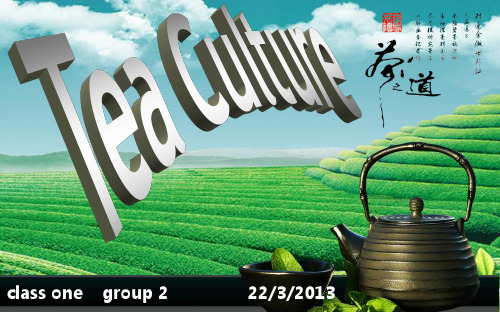
category
food significance
18
conclusion
Take the essence and discard the dregs.
It is a kind of art more than a drink. That is the tea culture.
7
Big Red Robe
Da HongPao is a semi-fermented oolong tea.It gives a rich perfume,and the tasting is pure. It shows the feature of charm and elegant. It originated from wild rare tea plants that were found growing on the cliff of Wuyi Mountain. Da Hong Pao yields a golden yellow liquid that produces a pleasant long lasting aftertaste.
敬
怡
15
They are the highest level of self-cultivation.
16
conclusion
life is like drinking the tea. taste----reflect----treasure
17
comparision
Janpan Type tea ceremony is held in silence /classical musics Japanese green tea/Oolong tea/Japanese Matcha/Cold tea with sweet candies cultivate one's morality and learning manners. China celebration of wedding/ happy, fun green tea, black tea, blue tea, yellow tea, white tea and dark tea with dried fruits philosophy and religion/ “discovering the Dao”/inner souls.
关于茶文化的英语

关于茶文化的英语茶文化(Tea culture)在中国以及其他亚洲国家有着悠久的历史和传统。
下面是一些关于茶文化的英语内容:1. 茶的起源:Tea originated in China more than 5,000 years ago. Legend has it that Emperor Shen Nong discovered tea when some tea leaves accidentally fell into his boiling water.2. 茶的种类:There are various types of tea, including green tea, black tea, oolong tea, white tea, and herbal tea. Each type has its unique taste and health benefits.3. 茶道:The art of tea drinking is known as "tea ceremony" or "tea ceremony." It involves the preparation and consumption of tea with utmost care and attention to detail. The tea ceremony is seen as a way to cultivate mindfulness and appreciating the beauty of simplicity.4. 茶具:The tea set used in the tea ceremony often includes a teapot, tea cups, a tea tray, and other utensils. These items are usually made from porcelain or clay and are intricately designed.5. 茶师:A tea master is an expert in the field of tea making and tea culture. They have extensive knowledge of different tea types, brewing techniques, and the history of tea. Tea masters are often highly respected and sought after for their expertise.6. 茶与健康:Tea is known for its health benefits. It contains antioxidants and other compounds that can help boost the immunesystem, improve digestion, and reduce the risk of certain diseases. Many people incorporate tea drinking into their daily routine for its health-promoting properties.7. 茶文化的传播:Tea culture has spread beyond Asia and has gained popularity worldwide. Many countries now have their own unique tea traditions and tea ceremonies. For example, in Japan, the tea ceremony is known as "chanoyu" and has its own set of rules and rituals.以上是关于茶文化的一些英语内容,希望能对你有所帮助!。
茶文化英语句子

Tea culture茶文化China is the home of tea, and tea culture has a long history.中国是茶的故乡,茶文化也源远流长。
Tea is a drink that can excite people and is also one of the symbols of Chinese culture.茶是一种可以帮人提神的饮品,也是中华文化的象征之一。
In China, tea is not only a drink, but also a display of lifestyle and cultural spirit.在中国,茶不仅是一种饮品,更是一种生活方式和文化精神的体现。
China has a wide variety of tea, including green tea, black tea, oolong tea, white tea, yellow tea, etc.中国的茶叶品种繁多,其中包括绿茶、红茶、乌龙茶、白茶、黄茶等。
Each kind of tea has its own unique characteristics and taste, and different varieties are suitable for different people and occasions.每种茶叶都有其独特的特点和口感,品种不同适合的人群和场合也不同。
When drinking tea, Chinese people pay attention to the quality, color, taste and other aspects of the tea.喝茶时,中国人注重茶的品质、色泽、口感等方面。
The process of tea tasting is also a cultural activity, which requires a special tea set.品茶的过程也是一种文化活动,需要有专门的茶具。
茶文化英语作文60字
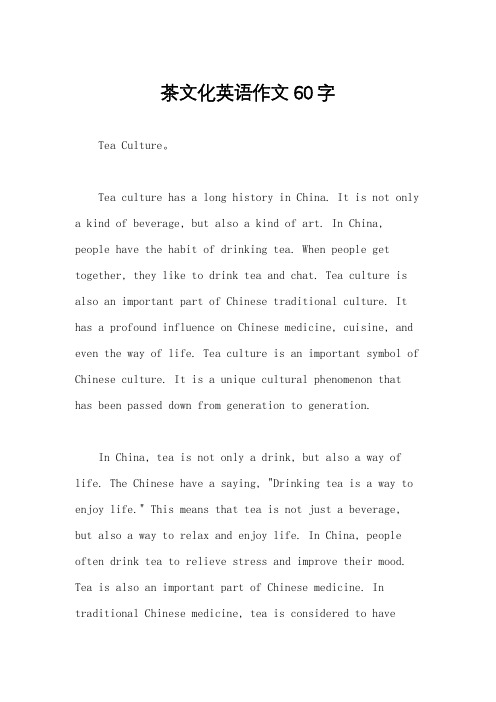
茶文化英语作文60字Tea Culture。
Tea culture has a long history in China. It is not only a kind of beverage, but also a kind of art. In China, people have the habit of drinking tea. When people get together, they like to drink tea and chat. Tea culture is also an important part of Chinese traditional culture. It has a profound influence on Chinese medicine, cuisine, and even the way of life. Tea culture is an important symbol of Chinese culture. It is a unique cultural phenomenon that has been passed down from generation to generation.In China, tea is not only a drink, but also a way of life. The Chinese have a saying, "Drinking tea is a way to enjoy life." This means that tea is not just a beverage, but also a way to relax and enjoy life. In China, people often drink tea to relieve stress and improve their mood. Tea is also an important part of Chinese medicine. In traditional Chinese medicine, tea is considered to havemany health benefits. It is believed that drinking tea can improve digestion, relieve fatigue, and even prevent disease. In addition, tea is also an important part of Chinese cuisine. In China, tea is often used as an ingredient in cooking. It is used to add flavor to dishes and enhance the taste of food.Tea culture is also an important part of Chinese social life. In China, people often drink tea when they meet friends or family. When people get together, they like to drink tea and chat. This is a way for people to relax and enjoy each other's company. Tea culture is also an important part of Chinese hospitality. When guests visit a Chinese home, they are often served tea as a sign of welcome and respect. In China, serving tea to guests is a way to show hospitality and create a warm and friendly atmosphere.In conclusion, tea culture is an important part of Chinese traditional culture. It has a long history and a profound influence on Chinese society. Tea is not only a drink, but also a way of life. It is a symbol of Chineseculture and an important part of Chinese social life. Tea culture is a unique cultural phenomenon that has been passed down from generation to generation. It is an important symbol of Chinese culture and an important part of Chinese society.。
茶文化英语作文初一
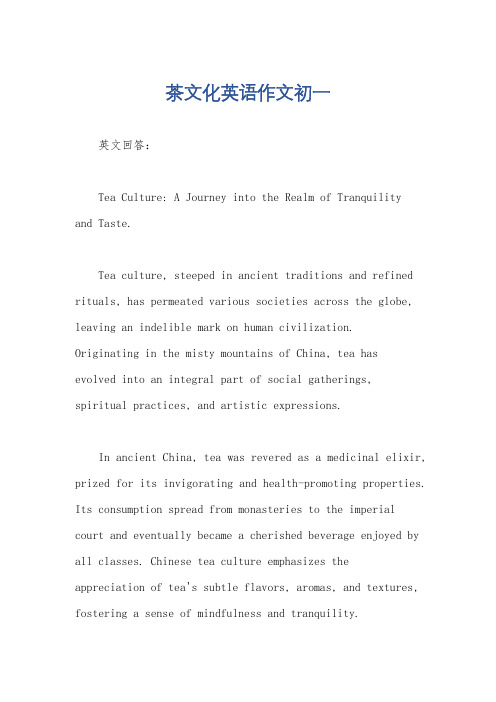
茶文化英语作文初一英文回答:Tea Culture: A Journey into the Realm of Tranquilityand Taste.Tea culture, steeped in ancient traditions and refined rituals, has permeated various societies across the globe, leaving an indelible mark on human civilization.Originating in the misty mountains of China, tea hasevolved into an integral part of social gatherings,spiritual practices, and artistic expressions.In ancient China, tea was revered as a medicinal elixir, prized for its invigorating and health-promoting properties. Its consumption spread from monasteries to the imperialcourt and eventually became a cherished beverage enjoyed by all classes. Chinese tea culture emphasizes theappreciation of tea's subtle flavors, aromas, and textures, fostering a sense of mindfulness and tranquility.Tea ceremonies, particularly in the Japanese tradition known as chanoyu, elevate the simple act of drinking tea into an art form. These rituals involve meticulously preparing and serving tea, creating a serene and harmonious atmosphere conducive to reflection and introspection. The Japanese tea ceremony embodies principles of simplicity, purity, harmony, and respect, encouraging participants to find solace and enlightenment in the present moment.In many cultures, tea has become synonymous with hospitality and social bonding. The act of sharing a cup of tea fosters a sense of community and warmth. In the Middle East, the tradition of serving tea in small, intricately patterned cups has become a symbol of generosity and welcome. In India, chai, a spiced tea beverage, is deeply ingrained in the fabric of everyday life, acting as both a comforting drink and a social lubricant.The appreciation of tea has extended beyond its consumption to encompass its role in art and literature. Artists have captured the delicate beauty of tea plants,while poets and writers have waxed lyrical about its evocative aromas and flavors. The Japanese tea ceremony has inspired numerous works of art, from intricate teacups to serene paintings, reflecting the profound cultural significance of tea in Japanese society.Tea culture continues to evolve and adapt to the changing times. While traditional rituals remain cherished, modern innovations have emerged, catering to the fast-paced lifestyles of contemporary society. Tea-infused beverages and desserts have become increasingly popular, blending the timeless appeal of tea with modern tastes.中文回答:茶文化,宁静与品味的旅程。
- 1、下载文档前请自行甄别文档内容的完整性,平台不提供额外的编辑、内容补充、找答案等附加服务。
- 2、"仅部分预览"的文档,不可在线预览部分如存在完整性等问题,可反馈申请退款(可完整预览的文档不适用该条件!)。
- 3、如文档侵犯您的权益,请联系客服反馈,我们会尽快为您处理(人工客服工作时间:9:00-18:30)。
茶文化是中国传统文化的重要组 成部分,有着悠久的历史。
• With a long history, tea culture is an important part of Chinese traditional culture.
中国是茶的故乡。据说早在五六千 年前,中国就有了茶树(tea- shrub), 而且有关茶树的人类文明可以追溯 到两千年前。 • China is the homeland of tea. It is believed that China has tea- shrubs as early as five to six thousand years ago,and human cultivation of tea plants can date back two thousand years.
• The study of tea covers a wide field and has a very rich content. Chinese tea may be classified into five types of teas according to the different methods by which it is processed. They are: Green tea, Black tea, Wulong tea, Compressed tea and Scented tea.
茶研究涉及的范围很广,有着丰富的 内容。中国茶根据它的不同的处理方 法可分为五种茶。它们是:绿茶,红茶, 其他种 类的味道和外观。
• Each kind is different from
others in flavor and appearance.
绿茶是办公室职员的最佳选择,它 有助于防止电脑辐射(computer radiation),补充人体水分(moisture content)。 • Green tea is the best option for office workers since it can help prevent computer radiation and supplement moisture content of the human body.
Thank you
一代代的种植者和生产者使中国 制茶工艺变得日臻完善。茶和中 国文化有着极其紧密的联系。
• Generations of growers and producers have perfected the Chinese way of manufacturing tea. Tea has an extremely close relationship with Chinese culture.
